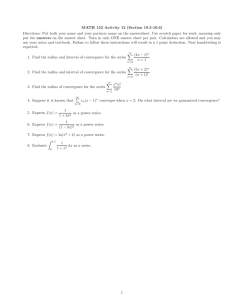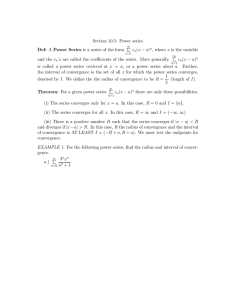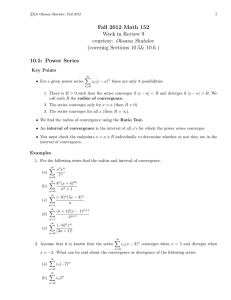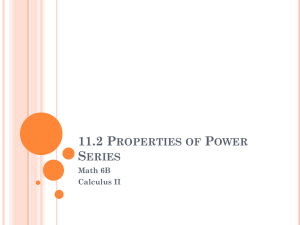Document 10504224
advertisement
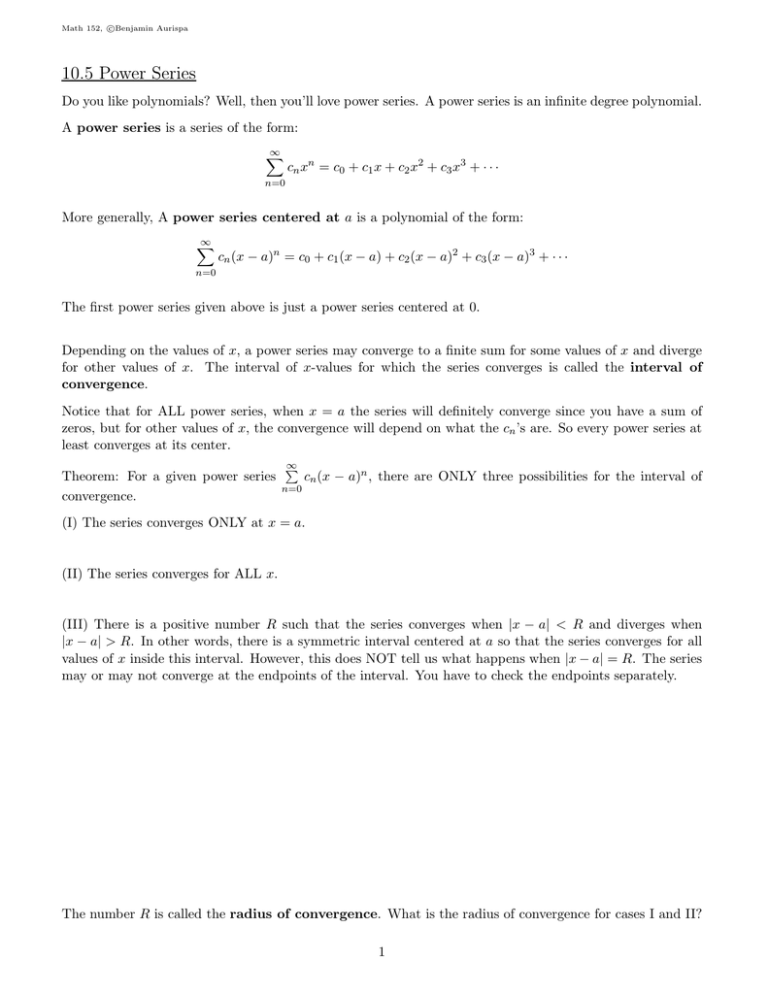
c Math 152, Benjamin Aurispa 10.5 Power Series Do you like polynomials? Well, then you’ll love power series. A power series is an infinite degree polynomial. A power series is a series of the form: ∞ X cn xn = c0 + c1 x + c2 x2 + c3 x3 + · · · n=0 More generally, A power series centered at a is a polynomial of the form: ∞ X cn (x − a)n = c0 + c1 (x − a) + c2 (x − a)2 + c3 (x − a)3 + · · · n=0 The first power series given above is just a power series centered at 0. Depending on the values of x, a power series may converge to a finite sum for some values of x and diverge for other values of x. The interval of x-values for which the series converges is called the interval of convergence. Notice that for ALL power series, when x = a the series will definitely converge since you have a sum of zeros, but for other values of x, the convergence will depend on what the cn ’s are. So every power series at least converges at its center. Theorem: For a given power series convergence. ∞ P n=0 cn (x − a)n , there are ONLY three possibilities for the interval of (I) The series converges ONLY at x = a. (II) The series converges for ALL x. (III) There is a positive number R such that the series converges when |x − a| < R and diverges when |x − a| > R. In other words, there is a symmetric interval centered at a so that the series converges for all values of x inside this interval. However, this does NOT tell us what happens when |x − a| = R. The series may or may not converge at the endpoints of the interval. You have to check the endpoints separately. The number R is called the radius of convergence. What is the radius of convergence for cases I and II? 1 c Math 152, Benjamin Aurispa Examples: Determine the radius and interval of convergence for the following power series. ∞ X 5n xn n=0 n! ∞ X xn n(−6)n n=1 2 c Math 152, Benjamin Aurispa ∞ X 3n(x − 2)n n=1 5n−1 ∞ X (2n)!(x + 6)n n=0 n+4 3 c Math 152, Benjamin Aurispa ∞ X (−4)n (2x − 5)n n=0 n2 + 5 4 c Math 152, Benjamin Aurispa ∞ X (3x + 1)n n=2 7n ln n Suppose we know that the series series converge? ∞ X cn 8n ∞ X cn (−6)n ∞ X cn ∞ X (−1)n cn 4n ∞ X cn xn converges for x = 4 and diverges for x = −7. Do the following n=0 n=0 n=0 n=0 n=0 5 c Math 152, Benjamin Aurispa Suppose it is known that the series ∞ X an (x − 2)n converges when x = 5. On what interval can we guarantee n=0 convergence based on this information? 10.6 Representations of Functions as Power Series Recall that the sum of a geometric series, ∞ P n=0 So, the power series ∞ P n=0 xn = ar n is a as long as |r| < 1. 1−r 1 as long as |x| < 1. The radius of convergence is 1 and the interval of 1−x convergence is (−1, 1). Find a power series representation for the following functions. What is the radius of convergence for each? 4 f (x) = 1 − 5x f (x) = x 7−x 6 c Math 152, Benjamin Aurispa f (x) = 2x5 4 + x2 Find the sum of the series ∞ X 2n x3n n=0 4(−5)n . What is the radius of convergence? 7 c Math 152, Benjamin Aurispa We can differentiate and integrate power series by remembering that a power series is just an infinite degree polynomial. Given f (x) = ∞ P n=0 (1) f ′ (x) = ∞ P n=1 (2) Z cn xn = c0 + c1 x + c2 x2 + c3 x3 + · · ·, ncn xn−1 = c1 + 2c2 x + 3c3 x2 + · · · f (x) dx = C + ∞ X cn xn+1 n=0 n+1 = C + c0 x + c1 x2 c2 x3 + + ··· 2 3 Imnportant Notes; • When differentiating a power series, the starting index can increase by one if the first term of the original series was a constant. • If the radius of convergence of the original power series is R, then it remains R after differentiating or integrating. • However, the interval of convergence may change, meaning that convergence at the endpoints may change. Find power series centered at 0 for the following functions. Determine the radius of convergence for each. f (x) = 1 (5 + x)2 8 c Math 152, Benjamin Aurispa f (x) = x (3 − 5x)2 f (x) = ln(1 + x) 9 c Math 152, Benjamin Aurispa f (x) = x2 ln(3 − x7 ) f (x) = arctan x 10 c Math 152, Benjamin Aurispa Integrate Z Evaluate Z 0 x3 arctan(7x2 ) dx as a power series. 1/2 x4 1 dx as a series. +1 Approximate this integral correctly to within an error of 0.0001. 11
